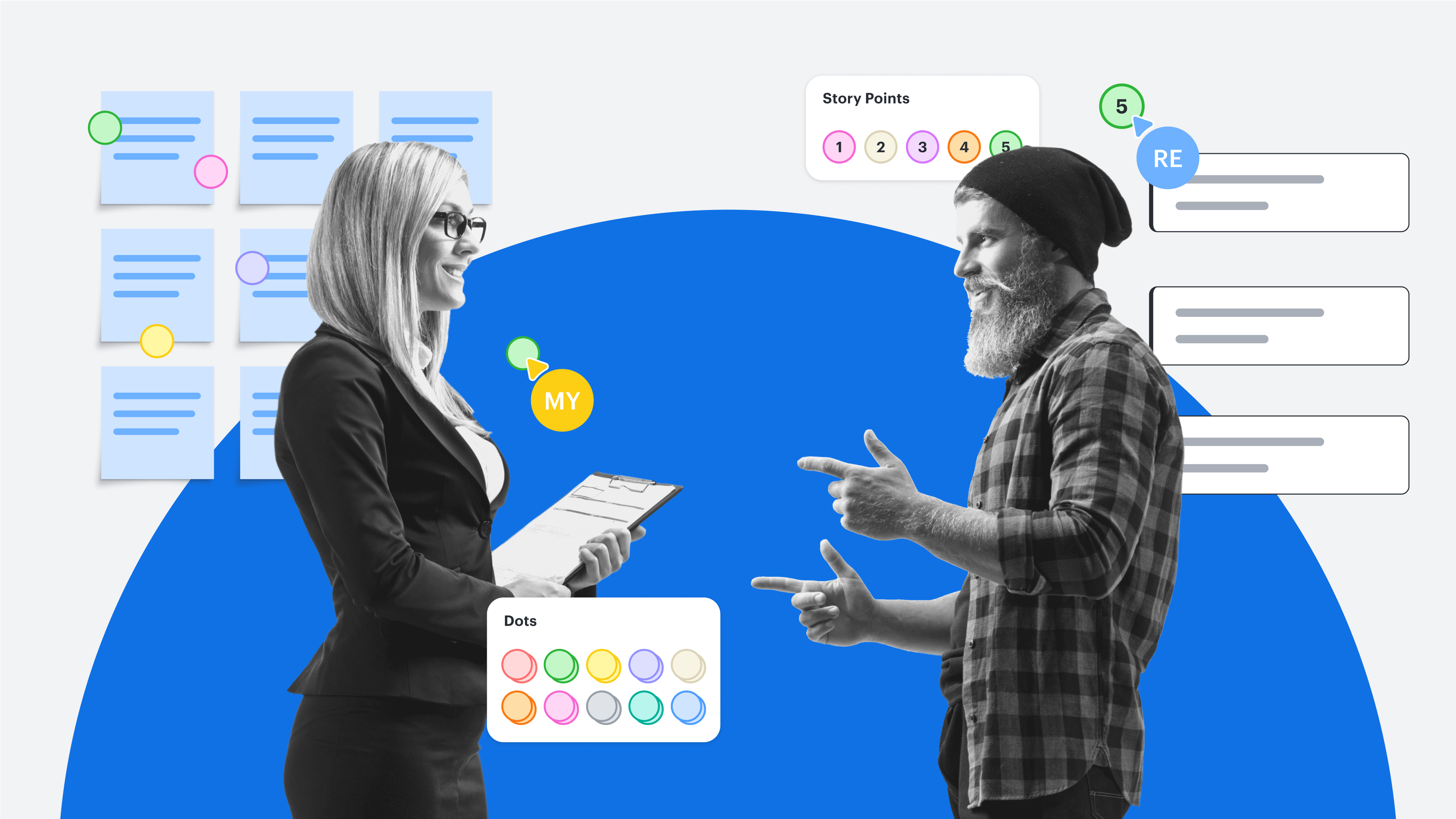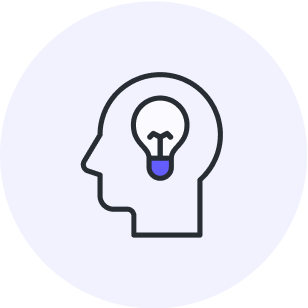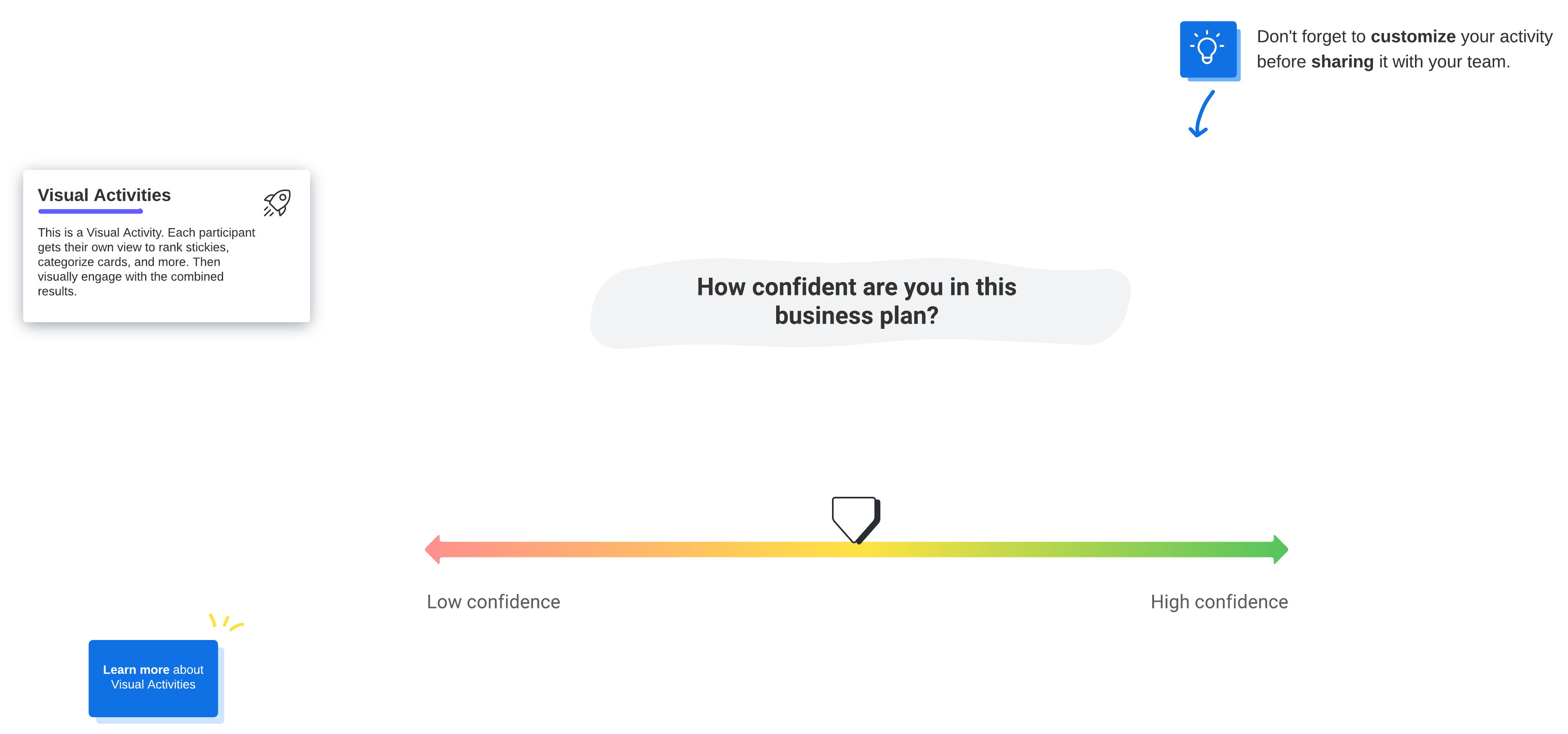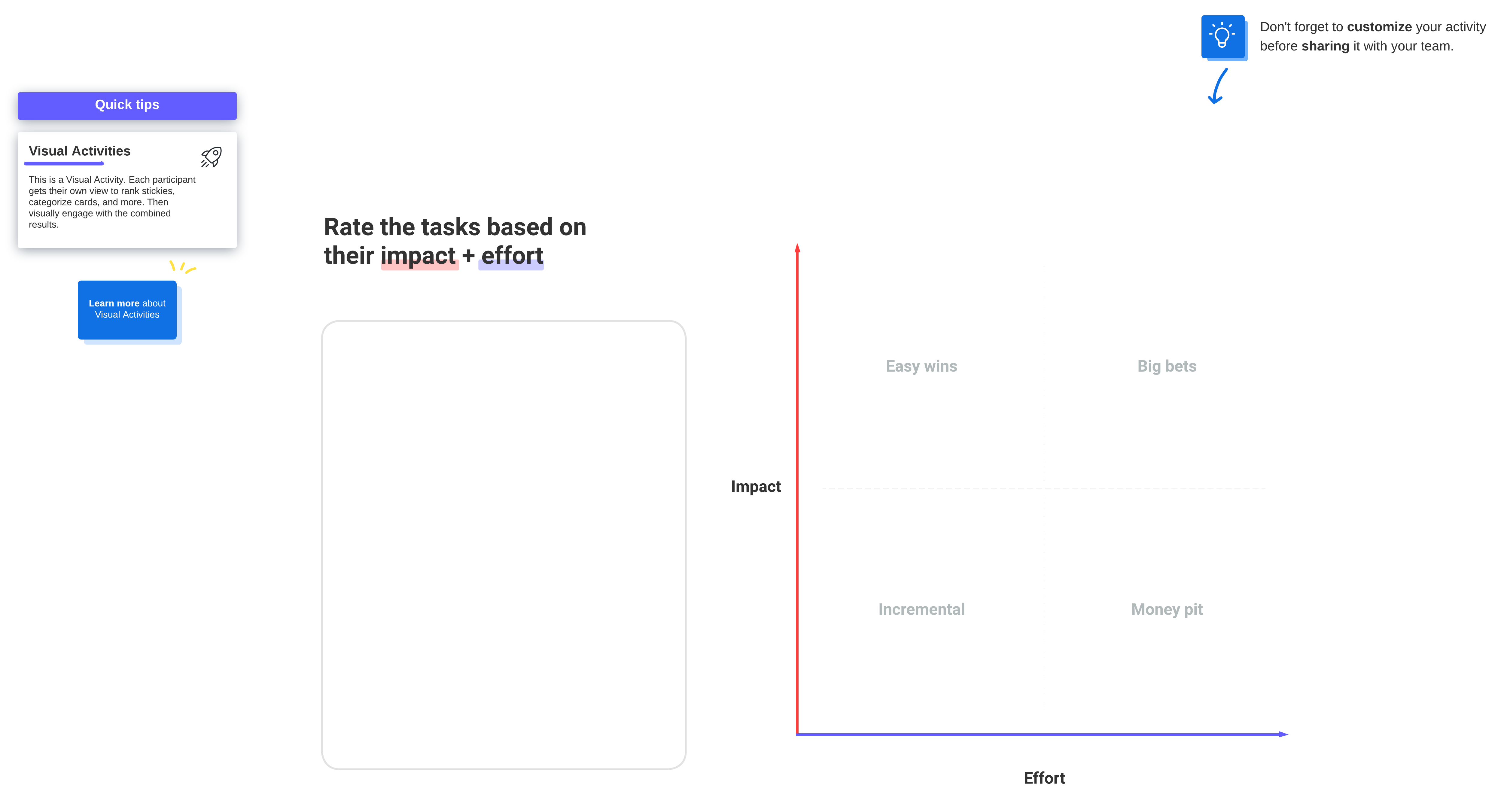
Consensus-building techniques to promote efficient, inclusive decision-making on your team
Reading time: about 12 min
Topics:
Achieving consensus on your team isn’t always easy— especially when team members are spread across time zones or locations. Without the right techniques, it may seem like you’ve reached a consensus when, in reality, team members weren’t provided with an easy way to weigh in.
Consensus building should embrace disagreement and ensure that all voices are heard for successful decision-making. Teams that truly reach an inclusive consensus are more likely to be motivated, innovative, and engaged, as consensus not only impacts your business but also individual ownership.
How can teams today reach consensus in a way that’s inclusive and collaborative? Learn how to truly reach consensus with tips and techniques you can apply no matter where you’re working from, and reach an equitable decision that strengthens collaboration among your team.
What is consensus building, and why is reaching consensus important?
Consensus building is a decision-making technique that ensures your team is aligned and feels comfortable moving forward with a task or initiative that has been agreed upon. For example, during big room planning, Agile teams need to reach a consensus on the work that’s to be completed in an upcoming quarter. Or, maybe your team has started using a new project management tool, and you need to reach a team consensus on how to use that new tool, agreeing on how often people will update their tasks and communicate when projects are completed.
For consensus building, not every team member may be in complete agreement or like the changes that are happening, but you need everyone to at least agree to support the plan. (For example, not everyone will like a new project management tool, but they need to agree to use it in a manner consistent with the rest of the team). The point of consensus is reaching a decision that everyone can commit to, even if it wasn’t their first choice.
“100% agreement should never actually be the goal to consensus. The goal is to get people bought in enough that they’re willing to commit to achieving the outcome in an aligned way.”
—Christopher Bailey, principal professional services consultant, Lucid
It’s also important to note that there is a difference between reaching a consensus with your team and receiving feedback or input. An essential aspect of successful consensus building is recognizing that difference and knowing when you need to get consensus versus input from your team.
You need input when:
-
There’s uncertainty or confusion among team members about a project, task, or other element of their work (such as how their work performance will be reviewed).
-
You’re gauging capacity and seeing how much work team members can take on.
-
You’re trying to get a sense of how team members are feeling about an upcoming project.
You need consensus when:
-
You require general buy-in in order to move forward with a goal or initiative.
-
You’re making changes to your team working agreement, such as the best communication channels to reach each other.
-
You’re implementing a new tool and need your team to agree on how everyone will use that tool.
Benefits to consensus building
Consensus building is important because not only does this decision-making approach help your team move forward and establish alignment, but it also provides benefits to your team, including:
-
An increased sense of ownership. When team members feel that they have a role in decision-making and that their voices matter, this can increase motivation and engagement. People are more committed to the work itself, which can improve overall performance.
-
Enhanced collaboration. Teams learn how to work together and move forward even if they don’t see completely eye to eye. Individuals also feel more comfortable speaking up and providing their honest opinions, even if they’re the lone voice of dissent.
-
More frequent innovation. Reaching consensus means acknowledging every voice. Getting everyone’s opinion is a great way to foster creativity and innovation, as people bring diverse perspectives to the table.

Learn the benefits of divergent thinking in the workplace
Learn how embracing diverse perspectives can boost engagement and innovation.
Read moreConsensus-building techniques
You can achieve consensus in person or virtually with the help of consensus-building techniques. These techniques can be used with the aid of visual collaboration tools to ensure that everyone approaches the meeting with the same context and understanding and has the opportunity to make equal contributions.
The overarching approach to consensus that many teams take is to begin with discussion, then testing alignment with the following techniques, resolving any outstanding differences, and ending with commitment. In some cases, however, you can start with a consensus technique—for instance, using fist to five to gauge how aligned everyone is before you begin the discussion. Either approach works; exactly when you use these techniques in your consensus-building meeting depends on the situation and your team.
Some common consensus-building techniques include:
-
Confidence voting, in which team members use a sliding scale to indicate how confident they are in a business plan or initiative.
-
Disagree and commit, in which team members disagree or dislike a result but commit to supporting it. This practice helps companies avoid the common trap of inaction due to one person (or more) disagreeing with certain details of a decision or initiative.
-
Fist to five, which helps teams quickly gauge consensus. Each person indicates their level of agreement by holding up a certain number of fingers—typically, five fingers is the highest level of agreement, with one finger the lowest.
-
Roman voting (a simple thumbs up or thumbs down to signal agreement).
-
Dot voting, which is especially helpful for quick group decisions. Dot voting helps you identify your team’s preferences from a list of options and ensures that everyone has an equal voice.
-
Task estimation, which helps you achieve consensus on workload estimates. Using team estimation shapes is a great way to align on tasks. You can also use an Agile estimation technique such as planning poker to agree on how long a task may take to complete.

A visual collaboration platform not only has tools and templates to help you facilitate these consensus-building techniques, but it also naturally records the results of your consensus-building activities. By keeping a record of your decisions, your team can stay aligned on what exactly was agreed upon, and you can see over time which techniques are particularly effective for your team. You can also easily share the results with stakeholders.
4 Tips to efficiently build consensus
Now that you’re familiar with consensus-building techniques, there are a few best practices to keep in mind to ensure you’re hearing from everyone equitably. These tips will also help you facilitate decision-making with your team.
Tip #1: Provide clarity in advance through asynchronous collaboration
Often, people dive right into a consensus-building discussion and assume team members are on the same page when they aren’t—which leads to wasted time and an unresolved agenda. If you don’t clarify expectations, you won’t be spending your time effectively when it’s the moment to reach a consensus.
“During consensus-building, decisions can get dragged along. It helps to establish deadlines and let people know why and when you need to make a decision. The first thing that should be addressed as you try to reach consensus is clarity.”
—Jeff Rosenbaugh, senior director of professional services, Lucid
It helps to establish context ahead of time and allow your team time to prepare before the actual consensus-building meeting. By sharing information—and even getting a feel for alignment—in advance, you can jump right into consensus-building techniques.
Before your consensus meeting, prepare your team by sharing an agenda and asking them to contribute to an activity, such as an impact versus effort matrix. These activities can help you get a sense of alignment and morale, as well as guide your discussion.

Achieving consensus is also more efficient when your team identifies what can be done asynchronously—such as setting expectations and providing clarity, as discussed above—and what should be saved for synchronous collaboration.
Synchronous meetings, in which you are all together in real time (whether in person or hybrid) are the best for actual consensus building, but there’s a lot you can accomplish asynchronously. By collaborating asynchronously, team members can contribute their thoughts on their own time, and you can recognize where you have disagreement.
Use a visual collaboration platform to facilitate consensus building in real time and provide your team with all the information they need asynchronously.

Your complete guide to asynchronous collaboration
Learn more about understanding when to collaborate synchronously or asynchronously.
Get the guideTip #2: Normalize healthy disagreement and dissent
100% agreement is not usually the goal of consensus building, but it’s common for decisions to take a while because one person isn’t agreeing or is playing devil’s advocate. Remember, achieving consensus means having everyone buy into a solution and support it—which doesn’t necessarily mean that each person will be happy.
Teams that successfully reach consensus create space for dissent. These teams approach consensus-building exercises with an open mind and normalize contributory dissent—intentional, divergent discussions about important work issues that allow team members to express their differences. This approach also helps to support psychological safety, in which people feel safe at work to make mistakes and express their opinions without fear of retribution.
To normalize contributory dissent, you can practice these techniques:
-
Ritual dissent workshops, which allow teams to provide feedback in a productive, respectful way. These workshops are a great opportunity for individuals to express dissent and for leadership to receive a variety of opinions.
-
Premortem brainstorming, in which a team discusses ahead of time what might cause a project to fail and what can proactively be done to prevent this failure.
-
Seeding dissent, also known as sowing dissent. If you know that someone on the team feels differently than everyone else, you can encourage them to speak up, especially if they disagree with the majority opinion. You can also ask someone to speak up for those they know are hesitating or shying back. This technique encourages debate in a psychologically safe, positive manner.

How to embrace contributory dissent
Learn more about contributory dissent and how to embrace conflict at work.
Read moreTip #3: Make sure you capture every voice
One of the most important aspects to consensus building is providing the opportunity for every voice to be heard. This might not necessarily mean that you hear from every single member of your team or from every employee at the company, depending on the type of decision being made (for example, some decisions only require consensus from team leads, not the entire team). But once you’ve identified the individuals you need complete buy-in from, then each of those people should have the chance to express agreement or disagreement in an equitable way.
This is where collaboration equity comes in. Working location, different collaboration styles, and other factors such as seniority can affect people’s ability to contribute to consensus equitably. If you don’t take these differences into account and ensure everyone is heard, this increases the risk that true consensus won’t actually be reached.
Capturing every voice is the responsibility of the meeting facilitator. Facilitators should be an advocate for each individual, creating a safe space for everyone to share their thoughts and collaborate. Some helpful facilitation techniques for ensuring collaboration equity include:
-
Establishing and maintaining clear rules of engagement.
-
Facilitating small group work, as people often feel more comfortable speaking up in smaller groups. Breakout boards for meetings and ritual dissent workshops are great techniques for breaking your team up for effective collaboration.
-
Using a parking lot to save people’s ideas for later. You may not be able to address everything that’s brought up in a meeting, but keeping a record of ideas to loop back to ensures that no one’s contributions get lost.
-
Using tools such as private mode in visual collaboration software that enables team members to contribute their ideas anonymously so people feel more comfortable.

Tools and techniques for better business decisions
Get the full guide for accomplishing strategic decision-making on your team.
Get the guideTip #4: Break down decisions
A common struggle teams often face when building consensus is misunderstanding what exactly needs to be decided in the first place. After all, decisions are typically multi-faceted, with several different points of agreement to work through.
If you’re struggling to determine what you need consensus on, try breaking down decisions into smaller components.
For successful consensus building, it can help to break down decisions into smaller components. For example, teams need to reach a consensus on how best to communicate with each other. Rather than asking, “How will we talk to each other,” you can break that decision down into which specific messaging tools you’ll use (email or an instant-messaging system like Slack) and communication best practices (whether people are expected to respond outside of their normal work hours).
Ask yourself:
-
How can you agree on different components to achieve consensus?
-
What do you already align on?
-
Is there a lone voice of dissent that you can focus on, or is everyone unhappy?
Maybe one person on your team doesn’t mind being contacted outside of normal work hours, but everyone else would prefer not to. Achieving consensus is having that one person agree that they won’t message other people outside of core working hours (or at least, they won’t expect a response until the next morning). Then, you can move on to other aspects of your team’s communication standards.
Breaking down decisions changes how you approach the conversation and guides your decision-making for achieving consensus.
Using Lucid to build consensus
Consensus building is a challenge for many teams. It can be difficult to facilitate discussions, ensure collaboration equity, and determine where exactly you need consensus in the first place. By normalizing dissent and providing an equal opportunity for everyone to be heard, you can ensure that team members feel committed to a decision—even if they don’t 100% agree with it.
Using a visual collaboration platform helps you facilitate consensus building and provides a way for you to collaborate with your team asynchronously so you’re prepared for your consensus meetings ahead of time. Cultivate a psychologically safe environment and boost innovation as you improve your decision-making skills with consensus-building templates and enhanced facilitation tools. Ultimately, with the right approach and the right tools, you can achieve efficient, inclusive consensus on your team.

How Lucid helps make decisions
Learn how Lucid can help your team achieve consensus and make informed decisions.
Learn moreAbout Lucid
Lucid Software is the leader in visual collaboration and work acceleration, helping teams see and build the future by turning ideas into reality. Its products include the Lucid Visual Collaboration Suite (Lucidchart and Lucidspark) and airfocus. The Lucid Visual Collaboration Suite, combined with powerful accelerators for business agility, cloud, and process transformation, empowers organizations to streamline work, foster alignment, and drive business transformation at scale. airfocus, an AI-powered product management and roadmapping platform, extends these capabilities by helping teams prioritize work, define product strategy, and align execution with business goals. The most used work acceleration platform by the Fortune 500, Lucid's solutions are trusted by more than 100 million users across enterprises worldwide, including Google, GE, and NBC Universal. Lucid partners with leaders such as Google, Atlassian, and Microsoft, and has received numerous awards for its products, growth, and workplace culture.
Related articles
Guide to strategic decision-making: Tools and techniques to make better business decisions
Strategic decision-making is the backbone of great leadership, but it’s not always easy to implement. Get our best decision-making tips here.
How Lucid helps you make decisions with confidence
Learn about how Lucid helps streamline decision-making, visualize impact, capture feedback, and interpret data effectively.
How to embrace contributory dissent during collaboration
To truly innovate, teams need to achieve true alignment, which only comes after going through the process of debate, evaluation, and yes, even disagreement. Here are three techniques you can use to incentivize contributory dissent within your team.
Guide: The top Agile estimation techniques to enhance alignment and efficiency
Read about the top Agile estimation techniques and how to choose the one that’s right for your team.
